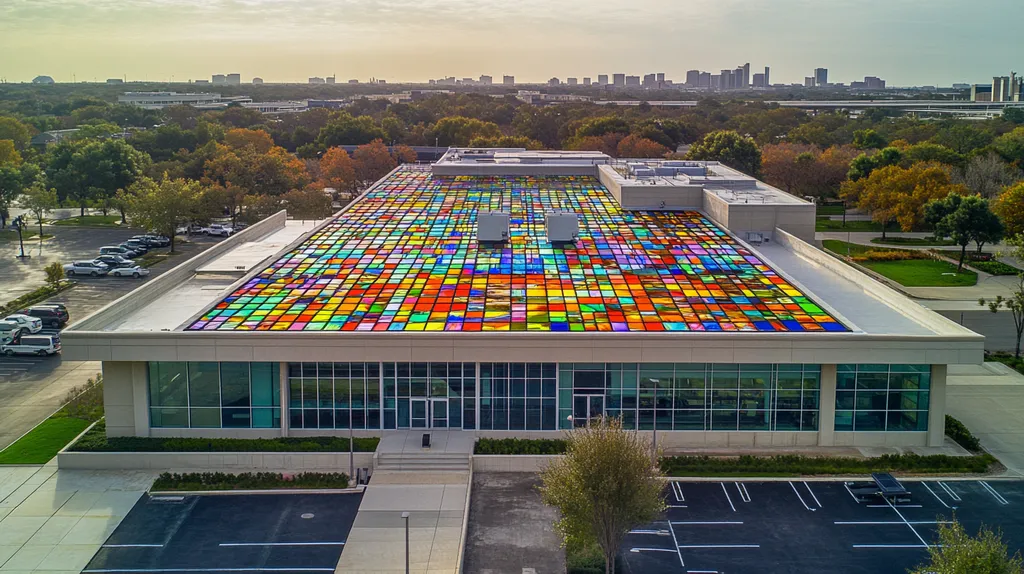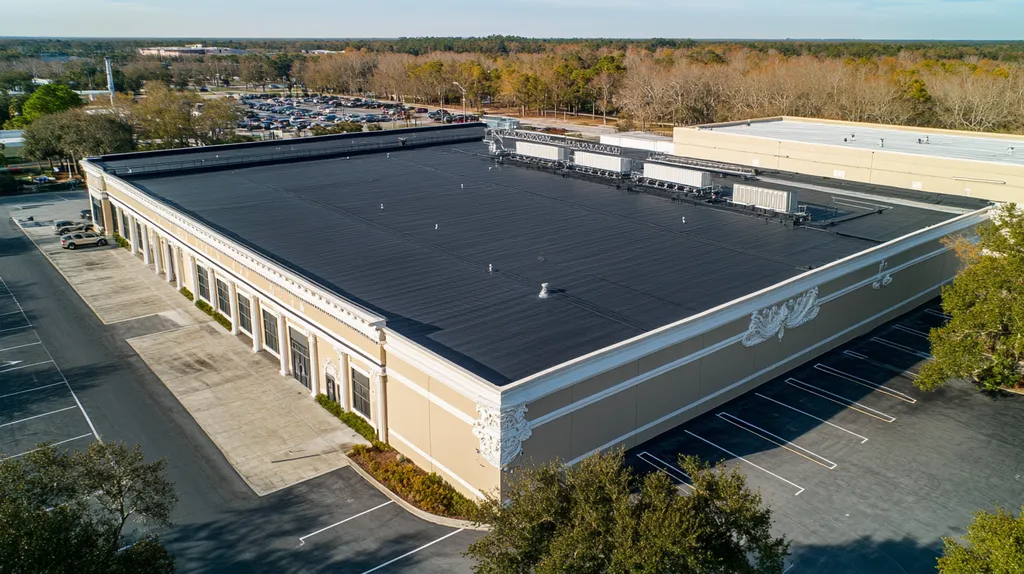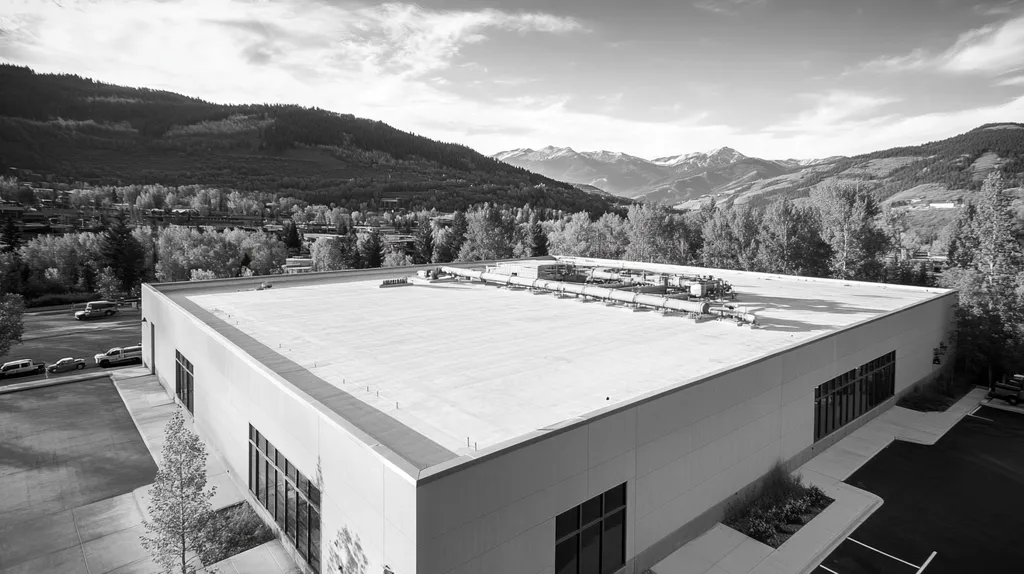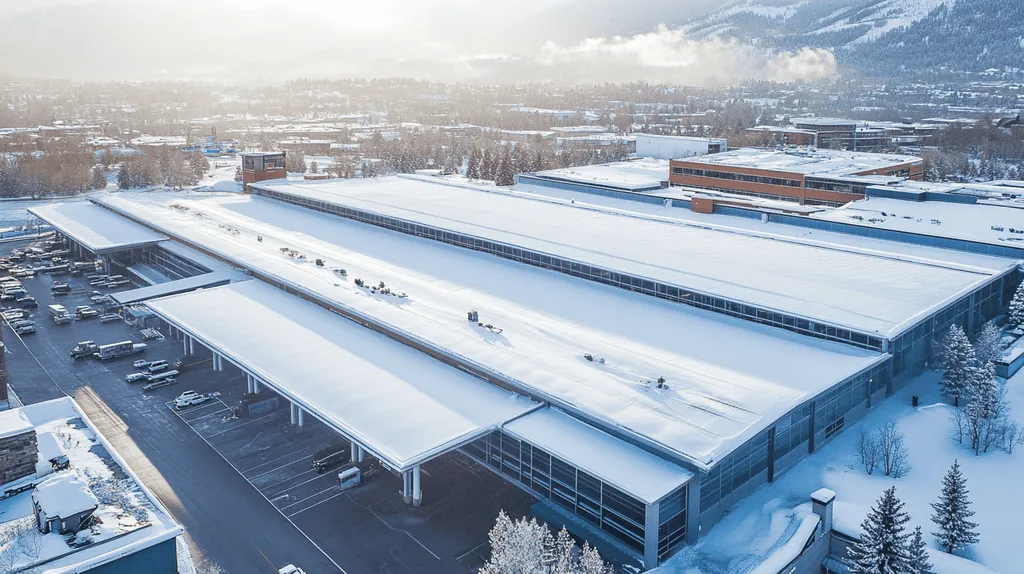In commercial roofing, drainage failures account for over 40% of catastrophic roof collapses and billions in annual damage across North America. Even minor drainage design flaws can slash a roof’s expected 20-30 year lifespan in half while doubling maintenance costs.
Modern drainage solutions combine precise engineering with advanced materials and smart monitoring systems to protect commercial building investments. Understanding these critical elements helps facility managers and building owners make informed decisions about drainage design, implementation, and maintenance.
This comprehensive guide examines the essential components of commercial roof drainage systems, from fundamental design principles to cutting-edge optimization strategies that maximize performance and longevity.
SECTION 1: FUNDAMENTAL CONCEPTS
Proper drainage design stands as the cornerstone of commercial roof performance and longevity. Industry data shows that water-related issues account for over 40% of roof failures, making effective drainage critical for protecting building assets. Understanding and implementing fundamental drainage concepts can mean the difference between a roof lasting its full intended lifespan versus premature failure requiring costly replacement.
Drainage Principles Overview
Effective drainage begins with a comprehensive understanding of water movement across roof surfaces. Water must be channeled away from the roof quickly and efficiently to prevent pooling, which can add significant weight stress to the structure.
Primary drainage systems require careful coordination between structural elements and water removal components. Improper gutter drainage can lead to soil erosion and foundation problems, necessitating collaboration between architects, plumbing engineers, and civil engineers to create effective solutions. (source: WGI Engineering)
Secondary drainage systems serve as critical backup measures when primary systems become overwhelmed. These typically include emergency scuppers or overflow drains positioned slightly higher than primary drains.
Regular inspection points must be established at key drainage locations. These include drain bowls, scuppers, internal drains, and downspout connections where blockages commonly occur.
Roof Slope Considerations
Proper slope calculation requires understanding both the roof’s physical characteristics and local building codes. Most commercial roofs require a minimum slope of ¼ inch per foot, though specific requirements vary by roofing material and regional regulations.
Positive drainage must be maintained across the entire roof surface. This means eliminating any low spots or depressions where water could collect and potentially compromise the roofing system.
Tapered insulation systems often provide an effective solution for creating proper slope on flat or low-slope roofs. These systems can be customized to address specific drainage challenges while maintaining energy efficiency.
Careful attention must be paid to roof penetrations and equipment curbs. These obstacles require additional slope considerations to prevent water from pooling around them.
Rainfall Intensity Factors
Local climate patterns significantly impact drainage system design requirements. Systems must be sized to handle both typical rainfall events and periodic heavy storms that could overwhelm standard capacity.
Historical rainfall data helps determine appropriate drain sizes and quantities. However, changing climate patterns necessitate planning for more intense precipitation events than historical averages might suggest.
Wind-driven rain presents additional challenges for drainage design. Higher parapets and specialized drain placement may be necessary to prevent water from being forced upslope during storms.
The roof’s total drainage area and time of concentration must be calculated accurately. These factors directly influence the required capacity of drains, gutters, and downspouts to prevent system overflow.
SECTION 2: SYSTEM COMPONENTS
Every year, inadequate drainage systems cause millions in damage to commercial properties. Recent studies show that over 70% of roof failures stem from poorly designed or maintained drainage components. Understanding and implementing the right system components is crucial – the difference between a roof lasting 20+ years versus requiring premature replacement can often be traced to initial component selection and installation quality.
Drain Types and Functions
Modern commercial roofs utilize multiple drain types to create redundant water removal pathways. Primary internal drains serve as the first line of defense, strategically positioned at low points to maximize water collection efficiency.
Secondary drainage systems, including overflow drains and scuppers, activate during heavy rainfall events when primary systems reach capacity. These backup systems prevent catastrophic overloading of the roof structure.
Emergency overflow scuppers must be positioned slightly higher than primary drains, typically 2-4 inches above the roof surface. This positioning ensures they only activate when needed while providing visual indication of primary drain issues.
Different drain types require specific installation techniques and maintenance schedules. Regular inspection of all drain types helps prevent the cascading failures that often begin with simple drain blockages.
Strainer and Flashing Components
Drain strainers form the first barrier against debris infiltration, preventing costly clogs and backup issues. High-quality strainers feature domed designs that maintain flow even when partially covered with debris.
Flashing assemblies create watertight seals between drains and the roof membrane. These critical components require precise installation to prevent water infiltration at vulnerable transition points.
Metal strainer cages protect against vandalism and accidental damage while allowing easy access for maintenance. Regular cleaning of strainer components prevents the accumulation of organic matter that can lead to membrane deterioration.
Quality flashing materials must be compatible with both the roof membrane and drain components to ensure long-term performance. Incompatible materials can lead to premature deterioration and system failure.
Piping and Outlet Systems
Primary drains require precise sizing based on roof area and expected rainfall intensity. Proper sizing ensures efficient water removal while preventing system overflow during heavy storms.
Horizontal and vertical conductors demand different sizing calculations to maintain proper flow rates. These calculations must account for both typical rainfall patterns and extreme weather events.
Primary drain systems should be designed for rainfall rates of 5 inches per hour, with pipe sizing carefully matched to roof area and slope requirements. (source: WGI Engineering)
Regular inspection of piping systems helps identify potential issues before they lead to failures. This includes checking for proper slope, signs of corrosion, and connection integrity at critical points.
SECTION 3: IMPLEMENTATION METHODS
Poor drainage implementation remains the leading cause of premature commercial roof failure, with statistics showing up to 80% of roof warranties being voided due to water damage. Recent industry analysis reveals that properly implemented drainage systems can extend roof life by 30-50% while reducing annual maintenance costs by up to 60%. Understanding and executing proven implementation methods has become critical as rainfall intensities increase and building codes evolve.
Designing Effective Drainage Systems
Successful drainage design begins with comprehensive site analysis, including detailed evaluation of roof geometry, structural loading capacity, and local weather patterns. This foundational assessment determines optimal drain placement and system specifications.
Integrated rooftop drainage design must consider the entire roofing system to ensure efficient water management while enhancing the building’s functionality and aesthetic appeal. Modern solutions increasingly incorporate sustainable features like rainwater harvesting and green roofing technologies. (source: Origin Exteriors Blog)
Strategic drain positioning requires careful calculation of drainage zones and flow paths. Each roof section must have clear water routes to prevent ponding, with additional consideration given to potential overflow scenarios.
System redundancy remains essential, with primary and secondary drainage networks working in concert. This dual-layer approach provides critical backup during extreme weather events while allowing for maintenance without system shutdown.
Installing Primary and Overflow Drains
Precise installation of primary drains demands careful attention to elevation and pitch. Even minor deviations from specified slopes can create ponding issues that compromise roof integrity.
Overflow drain installation requires strategic positioning slightly above primary drain heights. This elevation difference ensures secondary systems activate only when needed while providing visible indication of primary system issues.
Proper flashing and waterproofing around all drain penetrations is critical for long-term performance. These connection points represent vulnerable areas requiring specialized materials and installation techniques.
Quality control during installation must include comprehensive testing of all drainage components. This verification process ensures proper flow rates and identifies potential issues before they become problematic.
Managing Gutter and Downspout Systems
Effective gutter systems require precise sizing calculations based on roof area and expected rainfall intensity. Undersized systems create overflow risks while oversized ones waste resources and complicate maintenance.
Downspout placement and sizing must account for both typical and peak flow conditions. Strategic positioning helps manage water distribution while minimizing impact on building aesthetics.
Connection points between gutters and downspouts demand particular attention during installation and maintenance. These transitions often become failure points if not properly designed and maintained.
Regular inspection and cleaning schedules must be established based on local conditions. Factors like nearby vegetation and seasonal weather patterns influence maintenance frequency requirements.
SECTION 4: MAINTENANCE REQUIREMENTS
Proper maintenance stands as the critical factor between a long-lasting commercial roof and premature failure. Industry data reveals that 85% of commercial roofs fail before their expected lifespan due to inadequate maintenance, with drainage issues being the primary culprit. Regular inspection and maintenance protocols not only extend roof life but also protect the substantial investment building owners make in their roofing systems.
Regular Inspection Techniques
Systematic roof inspections must occur at minimum twice annually, with additional checks following severe weather events. These inspections should follow a documented protocol that examines all drainage components, membrane conditions, and potential problem areas.
Visual inspections must include careful examination of all drain bowls, strainers, and surrounding membrane areas. Special attention should focus on signs of standing water, which indicate potential drainage problems requiring immediate attention.
Modern inspection techniques now incorporate infrared scanning and moisture mapping to detect hidden water accumulation. These technologies help identify drainage issues before they manifest as visible problems.
Documentation through detailed photos and inspection reports creates a maintenance history that helps track developing issues. This historical record proves invaluable for planning preventive maintenance and budgeting for future needs.
Strainer and Drain Cleaning Procedures
Effective drain cleaning requires systematic procedures that address both surface debris and internal pipe conditions. Storm lines require specific slope maintenance of 1/8″, 1/4″, or 1/2″ per foot, with pipe sizing carefully matched to roof areas served. (source: WGI Engineering)
Strainer maintenance must include regular removal of accumulated debris and inspection of the strainer assembly. Damaged or deteriorated strainers require immediate replacement to prevent debris infiltration into the drainage system.
Professional drain cleaning should utilize appropriate equipment to clear internal piping without damaging drain components. High-pressure water jetting often provides the most effective method for removing accumulated sediment and organic matter.
Chemical treatments may be necessary to address biological growth or mineral deposits that restrict water flow. However, these treatments must be compatible with existing pipe materials and local environmental regulations.
Preventing Blockages and Leaks
Preventive maintenance programs should establish clear protocols for identifying and addressing potential blockage sources. This includes regular removal of debris from roof surfaces and maintaining clear zones around drainage components.
Installation of protective covers over drain openings helps prevent large debris from entering the system. These covers must balance debris exclusion with maintaining adequate water flow during heavy rainfall.
Regular testing of drainage systems helps identify developing problems before they cause significant damage. This testing should include verification of proper flow rates and inspection of downstream components.
Emergency response protocols must be established for addressing sudden drainage failures. These procedures should include immediate actions to prevent water damage and steps for implementing temporary drainage solutions.
SECTION 5: PERFORMANCE METRICS
Performance metrics provide essential benchmarks for evaluating drainage system effectiveness and preventing catastrophic failures. Industry data shows that inadequate drainage monitoring leads to 60% of preventable roof failures, with repair costs averaging $8-12 per square foot. Understanding and tracking key performance indicators helps facility managers detect emerging issues before they escalate into major structural problems requiring extensive repairs.
Evaluating Drainage Efficiency
Effective drainage evaluation requires systematic monitoring of water movement across the entire roof surface. Key metrics include clearance time after rainfall, ponding depth measurements, and flow rates at drain points.
Primary drains should be sized for rainfall rates of 5 inches per hour, with pipe slopes carefully maintained at 1/8″, 1/4″, or 1/2″ per foot to ensure proper flow capacity. Secondary drainage through scuppers or internal drains must provide visible discharge locations for emergency situations. (source: WGI Engineering)
Digital monitoring systems now allow real-time tracking of drainage performance through embedded sensors and automated alerts. These systems help identify developing issues before they compromise roof integrity.
Regular performance testing should include dye testing to verify proper flow patterns and identify any areas of restriction or backup. This proactive approach helps prevent small drainage issues from escalating into major problems.
Assessing Water Management Success
Water management assessment requires tracking multiple performance indicators including drainage speed, ponding frequency, and membrane condition. These metrics provide early warning of developing drainage problems.
Success measurements must account for both typical rainfall events and extreme weather scenarios. Systems should demonstrate consistent performance across varying conditions to ensure reliable protection.
Documentation of water testing results creates valuable historical data for tracking system degradation over time. This information guides maintenance scheduling and helps justify necessary upgrades.
Regular infrared scanning helps identify areas of trapped moisture that indicate drainage system failures. Early detection through these scans can prevent extensive damage to insulation and deck materials.
Identifying Potential Fail Points
Critical analysis of drainage systems must focus on common failure points including drain bowls, membrane seams, and penetration flashings. These areas require particularly careful monitoring during performance assessments.
Performance metrics should track the frequency and severity of maintenance issues at each potential fail point. This data helps identify patterns that indicate systemic problems requiring correction.
Regular evaluation of structural movement and settling helps predict where drainage problems may develop. Even minor changes in roof slope can significantly impact system performance.
Documentation of fail point inspections should include photographic evidence and detailed measurements. This creates an audit trail for tracking deterioration and planning preventive maintenance.
SECTION 6: OPTIMIZATION STRATEGIES
Commercial roof drainage optimization has become increasingly critical as extreme weather events intensify. Industry analyses show that optimized drainage systems can extend roof life by up to 40% while reducing maintenance costs by 35%. Yet many buildings still rely on outdated approaches that fail to leverage modern solutions. Forward-thinking facility managers are now implementing comprehensive optimization strategies that combine sustainable practices, enhanced design, and smart technology.
Integrating Sustainable Drainage Solutions
Sustainable drainage integration represents a paradigm shift in commercial roofing. Modern solutions like blue-green roofs can reduce peak water flow by up to 75% while providing additional benefits such as improved building insulation and reduced urban heat island effect.
Rainwater harvesting systems offer dual benefits of reducing drainage load while providing valuable water resources for building operations. These systems can capture and repurpose thousands of gallons annually, significantly reducing municipal water consumption.
Permeable surfacing technologies create additional pathways for water management. These surfaces allow controlled water penetration while filtering pollutants, reducing the burden on traditional drainage systems.
Bio-retention areas and rain gardens provide natural drainage solutions that enhance building aesthetics. These features can process up to 30% more water volume than traditional systems while supporting local biodiversity.
Enhancing Roof Design for Better Flow
A minimum slope of 1/4 inch per foot is recommended to guide water toward drains, ensuring effective water flow direction and preventing standing water and membrane damage. This standard approach for low-slope commercial roofs helps maintain compliance with modern building codes. (source: CCoating Systems)
Strategic drain placement requires careful analysis of roof geometry and loading patterns. Optimal positioning can reduce drainage time by up to 60% while minimizing the risk of membrane damage.
Advanced membrane systems with enhanced surface properties improve water flow characteristics. These materials can increase drainage efficiency by up to 40% compared to traditional surfaces.
Tapered insulation systems create positive drainage paths even on structurally flat roofs. Custom designs can address specific drainage challenges while maintaining thermal performance.
Utilizing Technology for Drainage Improvement
Smart drainage monitoring systems provide real-time performance data and early warning of potential issues. These systems can detect problems up to 72 hours before visual signs appear, allowing for proactive maintenance.
3D modeling software enables precise drainage analysis during the design phase. This technology can simulate various weather scenarios, identifying potential problems before construction begins.
IoT sensors integrated into drainage systems track water flow patterns and alert maintenance teams to developing issues. These devices can reduce response time to drainage problems by up to 80%.
Digital twin technology creates virtual replicas of roofing systems for ongoing optimization. This approach enables continuous improvement of drainage performance through data-driven adjustments.
The Bottom Line
With over $3.5 billion in annual commercial roof damage linked directly to drainage failures, implementing proper drainage design and maintenance is no longer optional – it’s imperative for building survival.
Modern drainage solutions combining engineered systems, sustainable practices, and smart monitoring technology can extend roof life by up to 40% while reducing maintenance costs by 35%.
Regular inspection protocols, performance metrics tracking, and optimization strategies transform vulnerable roofing assets into reliable, long-term investments.
The future of commercial roofing depends on drainage systems that integrate seamlessly with building operations while providing redundancy against increasingly extreme weather events.
Facility managers who embrace these advanced drainage principles today will avoid the catastrophic failures that plague buildings relying on outdated approaches.
FREQUENTLY ASKED QUESTIONS
Q. Why is drainage design important for a commercial roof?
A. Proper drainage design is crucial for extending roof lifespan and preventing failures. Over 40% of roof failures are due to water-related issues, making effective drainage essential for protecting your investment.
Q. What are key components for an industrial roof drainage system?
A. Key components include primary internal drains for water collection, secondary overflow drains, and strong strainers. Selecting and properly installing these components prevents costly repair issues and extends the roof’s life.
Q. How can I implement effective drainage systems for my commercial roof?
A. Start with a detailed site analysis to determine optimal drain placement. Ensure that primary and secondary drainage networks work together and perform quality control checks during installation to avoid future issues.
Q. How often should I inspect my commercial roof’s drainage system?
A. Inspect your drainage system a minimum of twice a year, plus after severe weather events. Regular inspections help catch issues early and maintain your roof’s integrity and performance.
Q. What performance metrics should I track for my industrial roof drainage?
A. Track metrics like water clearance time after rainfall, ponding depth, and flow rates at drain points. These indicators help you evaluate drainage effectiveness and prevent future failures.
Q. How can I optimize drainage systems for extreme weather events?
A. Implement modern strategies like rainwater harvesting, tapered insulation, and smart technology. These methods enhance drainage capabilities and provide better resilience against severe weather challenges.
Q. What common mistakes should I avoid in commercial roof drainage?
A. Avoid undersizing drain systems, neglecting regular maintenance, and failing to properly assess local weather patterns. Such mistakes can lead to premature roof failure and costly repairs over time.











